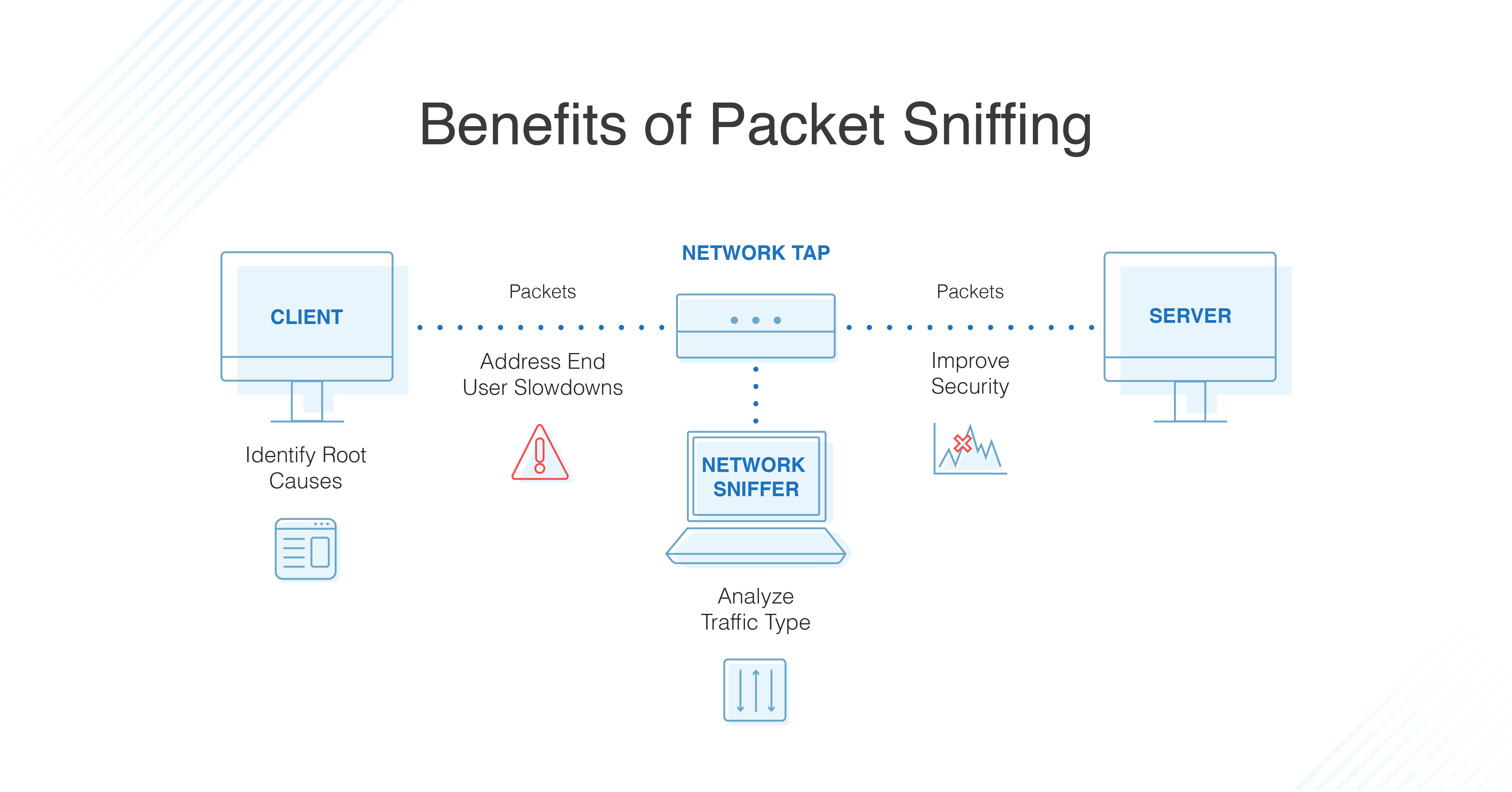Contents:
When it comes to relying on networking protocols, best practices, and monitoring tools to ensure data flow in a network, packet sniffing is the best option to help IT administrators keep up to date with packets (small formatted units of data) and ensure they’re transferred smoothly. While this technique is often associated with cyberattacks, it’s commonly used by Internet service providers, government agencies, advertisers, and even large organizations for network monitoring.
Therefore, as defined in our Cybersecurity Glossary,
A packet sniffer is a type of software designed to monitor and record traffic on a network. It can be used for good, to run diagnostic tests and troubleshoot potential problems. But it can also be used for malicious purposes, to snoop in on your private data exchanges. This includes: your web browsing history, your downloads, the people you send emails to, etc.
But how does a packer sniffer work? Simple – when data packets are transmitted, they pass through several nodes in a network. Each network adapter and the connected device examine a packet’s control information to see what node the packet is headed toward. If a node finds the packet is addressed to some other node, it drops or ignores the packet. In packet sniffing, on the other hand, some nodes are programmed to not follow this practice and collect all or a certain sample of packets, regardless of their destination.
As mentioned before, a packet sniffer can have both positive and negative use cases, depending on who is using it. Cyber attackers can exfiltrate sensitive information from unencrypted messages. If a user logs into websites over unencrypted transmission his credentials are exposed in plain text and can be easily intercepted by packet sniffers. Nevertheless, packet sniffing also offers many benefits I’ll discuss below.
Benefits of Using A Packet Sniffer

Image Source: DNSstuff
#1. It Detects the Root Cause of a Network Issue
Making sure all applications and servers within an organization run without any performance bottlenecks is a difficult task. When an issue occurs, it can be really hard to identify which network or app component caused the slowdown. For this reason, network admins continuously monitor their network for routine maintenance and optimization. With packet sniffers, they can collect information from all points of their network to quickly identify the components responsible for the delay.
#2. It Offers Performance Metrics for Different Access Points and Wireless Controllers
IT teams often perform Packet Capture analysis (PCAP) to measure the response times or network delays. It helps in determining the amount of time a packet takes to travel from a sender to a receiver. Additionally, they can identify congested links, detect the apps generating an unusual amount of traffic, and take remedial actions to resolve the issue. With packet sniffers, teams can get performance metrics for different access points and wireless controllers, correlate network data across the stack and minimize network downtime.
#3. It Provides Traffic Analysis
Using advanced IP sniffers and packet analyzers, IT teams can categorize the data based on destination server IP addresses, ports involved in communication, traffic volume, and more. With this analysis, it’s possible to distinguish critical traffic (required for VOIP, ERP suites, CRMs, etc.) from non-business traffic (social media, unauthorized messengers, etc.). What’s more, IT admins can filter and mark suspicious content.
#4. It Improves Bandwidth Management
Slow or intermittent networks can significantly impact business productivity and lead to huge losses. To avoid such issues, organizations rely on advanced network monitoring tools, which, in turn, rely on packet sniffing to analyze network traffic. Packet sniffers help prevent internal and external users to misemploy the network. With traffic analysis, IT teams can easily identify the traffic flow and WAN bandwidth usage, any irregular increase in network usage, and even restrict certain applications.
#5. It Assures Network Security and Compliance
Packet sniffers help in detecting a surge in traffic, attempts at network intrusion, and enable deeper evaluation and mitigation of security threats. They help in checking the status of WAN and endpoint security systems and also help in regulatory compliance documentation by logging all of the perimeter and endpoint traffic. What’s more, with packet sniffers, security teams can verify the effectiveness of their security setup consisting of firewalls, web filters, WAF, IPS/IDS systems, and more.

Heimdal® Network DNS Security
- No need to deploy it on your endpoints;
- Protects any entry point into the organization, including BYODs;
- Stops even hidden threats using AI and your network traffic log;
- Complete DNS, HTTP and HTTPs protection, HIPS and HIDS;
Packet Sniffing Best Practices
Now that I’ve pointed out the benefits of packet sniffers, let me detail some of the best practices for packet sniffing.
#1. Monitoring Requirements Understanding
When it comes to network monitoring, a strong understanding of networking concepts is mandatory. In general, IT specialists opt for the filtered mode to capture only the specific information from the packets when using a packet sniffer. Collecting packet data without knowing what information is essential for analysis is not enough. In many cases, it can result in information overload.
#2. Security Strengthening
Each packet contains a header identifying its source and destination IP and a payload. During data transfers, it’s crucial to make sure the payload is encrypted. Why? Since packet sniffers can also capture this data, any sensitive information can mistakenly get exposed if encryption isn’t in place. As an added layer of security, IT admins can configure packet sniffers to only copy the header data as it’s sufficient for network monitoring and analytics.
#3. Packet Sampling Implementation
Packet sampling can help to resolve the challenge of a large volume of data filling up disk space quickly. Instead of collecting data from every packet, IT teams are recommended to copy packet data at set frequencies. This way, they can provide satisfactory results over longer periods of monitoring.
Wrapping It Up…
Ensuring secure and reliable communications over different networks is a crucial requirement in IT operations. A packet sniffer can help you in this regard by targeting new resources when expanding your network capacity, managing your bandwidth, increasing efficiencies, ensuring business services delivery, enhancing security, ensuring data integrity, and improving the end-user experience.
What are your thoughts on packet sniffers? Would you and your organization invest in such a tool? Let me know in the comments below!


 Network Security
Network Security
 Vulnerability Management
Vulnerability Management
 Privileged Access Management
Privileged Access Management
 Endpoint Security
Endpoint Security
 Threat Hunting
Threat Hunting
 Unified Endpoint Management
Unified Endpoint Management
 Email & Collaboration Security
Email & Collaboration Security










